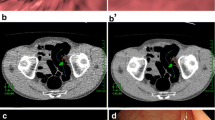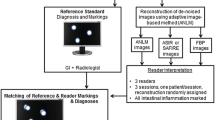Abstract
Purpose
To perform qualitative and quantitative comparison of images in same patients undergoing CT enterography (CTE) with 100 kVp iterative reconstruction and 120 kVp filtered back projection.
Methods
In this retrospective study, 50 consecutive patients who underwent imaging with 100 kVp and iterative reconstruction (100-IR) and had prior imaging with 120 kVp filtered back projection (120-FBP) were included. Subjective image quality parameters were evaluated by two independent and blinded readers, with higher score implying better image quality. We developed a quantitative measure of image sharpness by measuring edge-width of the psoas-fat interface. Image noise was measured as a standard deviation of attenuation measurement in the homogeneous region of the subcutaneous fat. Image sharpness and noise were measured and compared between 100-IR and 120-FBP acquisitions.
Results
There was approximately 33% lower radiation dose as estimated by CTDIvol with 100-IR compared to 120-FBP (9.95 vs. 15.0; p < 0.0001). There were no significant differences in overall image quality, bowel wall sharpness, and subjective assessment of noise and artifact between 100-IR and 120-FBP for both readers. Mesenteric vessel clarity score was significantly higher with 100-IR for 1 reader (4.34 vs. 4.04; p = 0.008), but not for the second reader. There was higher image sharpness (1.62 vs. 1.89; p < 0.0001) and higher image noise (14.4 vs. 13.2; p = 0.020) with 100-IR compared to 120-FBP acquisition.
Conclusions
CTE performed at 100 kVp with iterative reconstruction demonstrates dose reduction without significant impact on various measures of image quality when compared to conventional 120 kVp FBP.



Similar content being viewed by others
References
Hakim FA, Alexander JA, Huprich JE, Grover M, Enders FT (2011) CT-enterography may identify small bowel tumors not detected by capsule endoscopy: eight years experience at Mayo Clinic, Rochester. Dig Dis Sci 56(10):2914–2919. doi:10.1007/s10620-011-1773-0
Samuel S, Bruining DH, Loftus EV Jr, et al. (2012) Endoscopic skipping of the distal terminal ileum in Crohn’s disease can lead to negative results from ileocolonoscopy. Clin Gastroenterol Hepatol 10(11):1253–1259. doi:10.1016/j.cgh.2012.03.026
Bruder HR R; Sunnegardh J; Sedlmair M; Stierstorfer K; Flohr T (2011) Adaptive Iterative Reconstruction. In: Proceeding of SPIE Medical Imaging: Physics of Medical Imaging, vol 7961
McCollough CH, Bruesewitz MR, Kofler JM Jr (2006) CT dose reduction and dose management tools: overview of available options. Radiographics 26(2):503–512. doi:10.1148/rg.262055138
Yu Z, Thibault JB, Bouman CA, Sauer KD, Hsieh J (2011) Fast model-based X-ray CT reconstruction using spatially nonhomogeneous ICD optimization. IEEE Trans Image Process 20(1):161–175. doi:10.1109/TIP.2010.2058811
De Man B, Nuyts J, Dupont P, Marchal G, Suetens P (2001) An iterative maximum-likelihood polychromatic algorithm for CT. IEEE Trans Med Imaging 20(10):999–1008. doi:10.1109/42.959297
Park M, Chung YE, Lee HS, et al. (2013) Intraindividual comparison of diagnostic performance in patients with hepatic metastasis of full-dose standard and half-dose iterative reconstructions with dual-source abdominal computed tomography. Investig Radiol . doi:10.1097/RLI.0000000000000014
Wuest W, May MS, Scharf M, et al. (2013) Stent evaluation in low-dose coronary CT angiography: Effect of different iterative reconstruction settings. J Cardiovasc Comput Tomogr 7(5):319–325. doi:10.1016/j.jcct.2013.08.012
Shin HJ, Chung YE, Lee YH, et al. (2013) Radiation dose reduction via sinogram affirmed iterative reconstruction and automatic tube voltage modulation (CARE kV) in Abdominal CT. Korean J Radiol 14(6):886–893. doi:10.3348/kjr.2013.14.6.886
Kim SH, Baek SH, Yoon JH, et al. (2013) Quarter regular dose non-enhanced CT for urinary stone: added value of adaptive statistical iterative reconstruction. Acta Radiol . doi:10.1177/0284185113513761
Hoxworth JM, Lal D, Fletcher GP, et al. (2013) Radiation dose reduction in paranasal sinus CT using model-based iterative reconstruction. Am J Neuroradiol . doi:10.3174/ajnr.A3749
Ryska P, Kvasnicka T, Jandura J, et al. (2013) Reduction of effective dose and organ dose to the eye lens in head MDCT using iterative image reconstruction and automatic tube current modulation. Biomed Pap Med Fac Univ Palacky Olomouc Czech Repub . doi:10.5507/bp.2013.071
Williams MC, Weir NW, Mirsadraee S, et al. (2013) Iterative reconstruction and individualized automatic tube current selection reduce radiation dose while maintaining image quality in 320-multidetector computed tomography coronary angiography. Clin Radiol 68(11):e570–577. doi:10.1016/j.crad.2013.05.098
Hong SS, Lee JW, Seo JB, et al. (2013) Evaluation of image quality and radiation dose by adaptive statistical iterative reconstruction technique level for chest CT examination. Radiat Prot Dosimetry 157(2):163–171. doi:10.1093/rpd/nct127
Wu TH, Hung SC, Sun JY, et al. (2013) How far can the radiation dose be lowered in head CT with iterative reconstruction? Analysis of imaging quality and diagnostic accuracy. Eur Radiol 23(9):2612–2621. doi:10.1007/s00330-013-2846-6
Lee SJ, Park SH, Kim AY, et al. (2011) A prospective comparison of standard-dose CT enterography and 50% reduced-dose CT enterography with and without noise reduction for evaluating Crohn disease. Am J Roentgenol 197(1):50–57. doi:10.2214/AJR.11.6582
Hara AK, Paden RG, Silva AC, et al. (2009) Iterative reconstruction technique for reducing body radiation dose at CT: feasibility study. Am J Roentgenol 193(3):764–771. doi:10.2214/AJR.09.2397
Canny J (1986) A computational approach to edge detection. IEEE Trans Pattern Anal Mach Intell 8(6):679–698
Al-Hawary MM, Kaza RK, Platt JF (2013) CT enterography: concepts and advances in Crohn’s disease imaging. Radiol Clin North Am 51(1):1–16. doi:10.1016/j.rcl.2012.09.001
Higgins PD, Caoili E, Zimmermann M, et al. (2007) Computed tomographic enterography adds information to clinical management in small bowel Crohn’s disease. Inflamm Bowel Dis 13(3):262–268. doi:10.1002/ibd.20013
Bruining DH, Siddiki HA, Fletcher JG, et al. (2012) Benefit of computed tomography enterography in Crohn’s disease: effects on patient management and physician level of confidence. Inflamm Bowel Dis 18(2):219–225. doi:10.1002/ibd.21683
Chatu S, Subramanian V, Pollok RC (2012) Meta-analysis: diagnostic medical radiation exposure in inflammatory bowel disease. Aliment Pharmacol Ther 35(5):529–539. doi:10.1111/j.1365-2036.2011.04975.x
Cipriano LE, Levesque BG, Zaric GS, Loftus EV Jr, Sandborn WJ (2012) Cost-effectiveness of imaging strategies to reduce radiation-induced cancer risk in Crohn’s disease. Inflamm Bowel Dis 18(7):1240–1248. doi:10.1002/ibd.21862
Matsuki M, Murakami T, Juri H, Yoshikawa S, Narumi Y (2013) Impact of adaptive iterative dose reduction (AIDR) 3D on low-dose abdominal CT: comparison with routine-dose CT using filtered back projection. Acta Radiol . doi:10.1177/0284185113488576
Yasaka K, Katsura M, Akahane M, et al. (2013) Model-based iterative reconstruction for reduction of radiation dose in abdominopelvic CT: comparison to adaptive statistical iterative reconstruction. SpringerPlus 2(1):209. doi:10.1186/2193-1801-2-209
Schindera ST, Odedra D, Raza SA, et al. (2013) Iterative reconstruction algorithm for CT: can radiation dose be decreased while low-contrast detectability is preserved? Radiology . doi:10.1148/radiol.13122349
Gervaise A, Osemont B, Lecocq S, et al. (2012) CT image quality improvement using adaptive iterative dose reduction with wide-volume acquisition on 320-detector CT. Eur Radiol 22(2):295–301. doi:10.1007/s00330-011-2271-7
Co SJ, Mayo J, Liang T, et al. (2013) Iterative reconstructed ultra high pitch CT pulmonary angiography with cardiac bowtie-shaped filter in the acute setting: Effect on dose and image quality. Eur J Radiol . doi:10.1016/j.ejrad.2013.04.043
Yamada Y, Jinzaki M, Hosokawa T, et al. (2012) Dose reduction in chest CT: comparison of the adaptive iterative dose reduction 3D, adaptive iterative dose reduction, and filtered back projection reconstruction techniques. Eur J Radiol 81(12):4185–4195. doi:10.1016/j.ejrad.2012.07.013
Laqmani A, Buhk JH, Henes FO, et al. (2013) Impact of a 4th generation iterative reconstruction technique on image quality in low-dose computed tomography of the chest in immunocompromised patients. Rofo . doi:10.1055/s-0033-1335577
Shen J, Du X, Guo D, et al. (2013) Prospective ECG-triggered coronary CT angiography: clinical value of noise-based tube current reduction method with iterative reconstruction. PLoS One 8(5):e65025. doi:10.1371/journal.pone.0065025
Hou Y, Liu X, Xv S, Guo W, Guo Q (2012) Comparisons of image quality and radiation dose between iterative reconstruction and filtered back projection reconstruction algorithms in 256-MDCT coronary angiography. Am J Roentgenol 199(3):588–594. doi:10.2214/AJR.11.7557
Lin CJ, Wu TH, Lin CH, et al. (2013) Can iterative reconstruction improve imaging quality for lower radiation CT perfusion? Am J Neuroradiol . doi:10.3174/ajnr.A3436
Kaza RK, Platt JF, Al-Hawary MM, et al. (2012) CT enterography at 80 kVp with adaptive statistical iterative reconstruction versus at 120 kVp with standard reconstruction: image quality, diagnostic adequacy, and dose reduction. Am J Roentgenol 198(5):1084–1092. doi:10.2214/AJR.11.6597
Acknowledgement
Dr. James Babb, PhD for assistance with statistical analysis.
Author information
Authors and Affiliations
Corresponding author
Rights and permissions
About this article
Cite this article
Johnson, E., Megibow, A.J., Wehrli, N.E. et al. CT enterography at 100 kVp with iterative reconstruction compared to 120 kVp filtered back projection: evaluation of image quality and radiation dose in the same patients. Abdom Imaging 39, 1255–1260 (2014). https://doi.org/10.1007/s00261-014-0156-3
Published:
Issue Date:
DOI: https://doi.org/10.1007/s00261-014-0156-3




